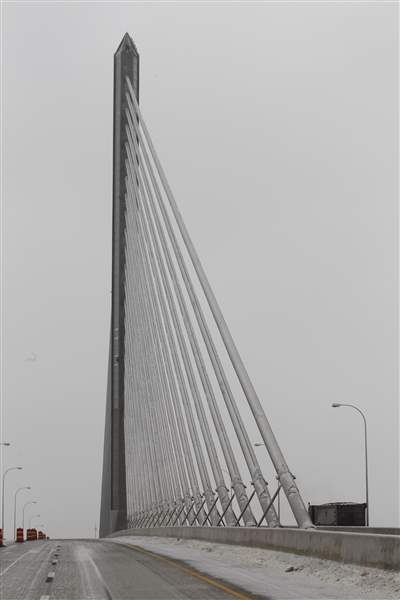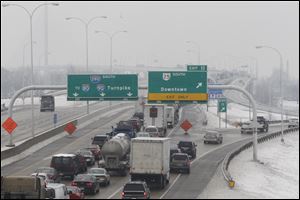
Falling ice puts skyway traffic in deep freeze
complete closure is span's first
2/25/2011
Ohio officials said they considered ice countermeasures when planning the $237 million bridge, but decided ice problems would be too rare to justify the cost.
the blade/jetta fraser
Buy This Image

Falling ice forced the closure of the Veterans' Glass City Skyway. Southbound traffic was halted for about an hour and northbound lanes were closed for most of the day.
“I can’t believe they don’t have a better system. They’ve had problems with this since the get-go,” said William Smith, a truck driver for Rodriguez Expedited Freight System, of Taylor, Mich., who was among southbound motorists delayed by the problem.
Northbound I-280 was closed for most of the day and southbound traffic was shut off for more than an hour because of ice falling from the bridge’s pylon and stay cables. The ice formed during freezing rain earlier this week.
On four previous occasions in recent years, lanes have been closed because of falling ice, but Thursday marked the first complete closure since the bridge’s opening in June, 2007. Traffic had been reduced to one lane from three in each direction since Monday because of the ice risk.
Theresa Pollick, a spokesman for the Ohio Department of Transportation district office in Bowling Green, said it was all a safety precaution because of the risks of falling ice either hitting vehicles or startling motorists when it struck the pavement.
“We do realize that it’s a big inconvenience for travelers, but safety has to come first,” Ms. Pollick said.
Hundreds of cars and trucks backed up to Navarre Avenue in Oregon on the northbound side during the bridge’s 9 a.m. closing and ODOT’s subsequent posting of a barricade and detour route at State Rt. 795 in Lake Township. Two of three northbound lanes reopened at about 5:30 p.m.
Southbound traffic also backed up at the closed bridge, but was allowed through starting at about 10:15 a.m. after officials determined that ice was falling only onto the northbound side.
The left lane remained closed in both directions Thursday evening.
On an average day, 70,000 cars and trucks cross the skyway, which opened as an I-280 replacement for the Craig Memorial Bridge.
The head of a University of Toledo research team studying the bridge’s ice issues said it will be at least three years before any sort of ice-control system is deployed on the bridge.
“We’re in the data-gathering phase right now,” said Rich Martinko, the university’s director of transportation research.
Any proposed solution, he said, would be tested in a cold-weather laboratory before its field introduction, “and first, we need to understand the icing” — how it accumulates and what conditions cause the ice to fall.
Terry Sutphen, a trucker from Norwalk, Ohio, who was delayed in the southbound traffic jam, said he understood the ice problem, but said he would have appreciated an earlier warning about the bridge closing — such as a sign on southbound I-75 alerting drivers so they could take a different route.
“I was coming up the ramp and I saw the plow truck ahead. I thought he was spreading salt, but he just stopped,” Mr. Sutphen said, adding that he had seen the lane closings on the bridge during his previous trips across it, but didn’t know the reason for them.
Ms. Pollick said that besides reducing the risk of ice striking vehicles, closing the bridge’s two left lanes in either direction after the ice storm Sunday night and Monday made it easier for ODOT to react quickly if the ice started shedding at a rapid rate, which it did Thursday morning when temperatures warmed well over the freezing point. State crews set up the northbound detour route as quickly as they could after the decision was made to close the bridge, she said.

Ohio officials said they considered ice countermeasures when planning the $237 million bridge, but decided ice problems would be too rare to justify the cost.
With no idea how long they might be delayed, some began driving the wrong way down entrance ramps to get off the bridge.
“I’m not sure if it’s safe to turn around,” said Bobbie Kehlmeier, of Genoa, who ended up being allowed to go forward after waiting in the southbound queue.
She hoped her employers at St. Charles Hospital would understand why she was late.
The drive back to Oregon after an appointment before work had put her on the bridge’s North Toledo approach viaduct when it closed.
Unique to this storm, Mr. Martinko said, was that ice formed not only on the skyway’s stay cables, but also on its center pylon’s inlaid glass panels, from which the ice fell Thursday in sheets that broke up in the air before shattering on the pavement.
The problem mainly affected the northbound lanes because during the ice storm, the wind was from the northeast, causing the most ice to accumulate on the pylon’s east side.
The first two ice-related incidents on the bridge occurred in 2007 and 2008. During the second one, on March 28, two vehicles were hit by falling ice, causing a combined $1,075 in damage but no injuries.
One vehicle’s windshield was smashed, but did not collapse into its cabin.
ODOT closed lanes on the bridge twice more during the 2008-09 winter, but not at all last winter.
Mr. Martinko said this week’s storm provided researchers with the first opportunity to test mathematical formulas they derived, based on weather records, to predict when ice was likely to form and fall from the skyway.
“It was no surprise to us that the bridge closed today [Thursday],” Mr. Martinko said. But until the formulas are proven consistently accurate, he said, the research team is hesitant to tell ODOT to rely on them.
Ms. Pollick said the department had been on alert Wednesday because weather forecasts predicted sunshine, which also can thaw ice on the bridge’s structures even if temperatures are colder. But it remained cloudy all day in Toledo and the ice didn’t fall.
ODOT officials acknowledged in late 2007 that they considered ice “countermeasures” during planning for the $237 million skyway’s construction, but decided ice problems would be too rare to justify the cost.
Mr. Martinko, who headed the department’s Bowling Green office during the bridge’s design, defended that decision Thursday, saying that ice-control measures available at the time were unproven and costly.
“You don’t want to put something up there that’s very expensive and doesn’t work,” he said.
Options being researched, Mr. Martinko said, include a “drip-tube” system that would apply an agricultural deicing chemical to the bridge’s stay-cable sheaths when ice conditions are forecast and a forced-air heating system inside those sheaths to warm them above freezing.
But even with systems such as those, he said, “there’s no guarantee that the bridge will always be totally ice-free.”
In the meantime, an unrelated ODOT project to erect programmable traffic-alert signs near key junctions on the Toledo-area freeway system should help with notifying motorists about skyway ice problems.
The transportation department plans to start putting the signs up this summer and have all in place by late 2012.
But Ms. Pollick said ODOT has no plan to erect gates or signs that could be deployed automatically at I-280 entrances closer to the bridge, such as the Greenbelt Parkway or Front Street ramps that feed directly onto the structure, so that traffic can be shut off immediately once authorities decide to close it.
Contact David Patch at:
dpatch@theblade.com
or 419-724-6094.